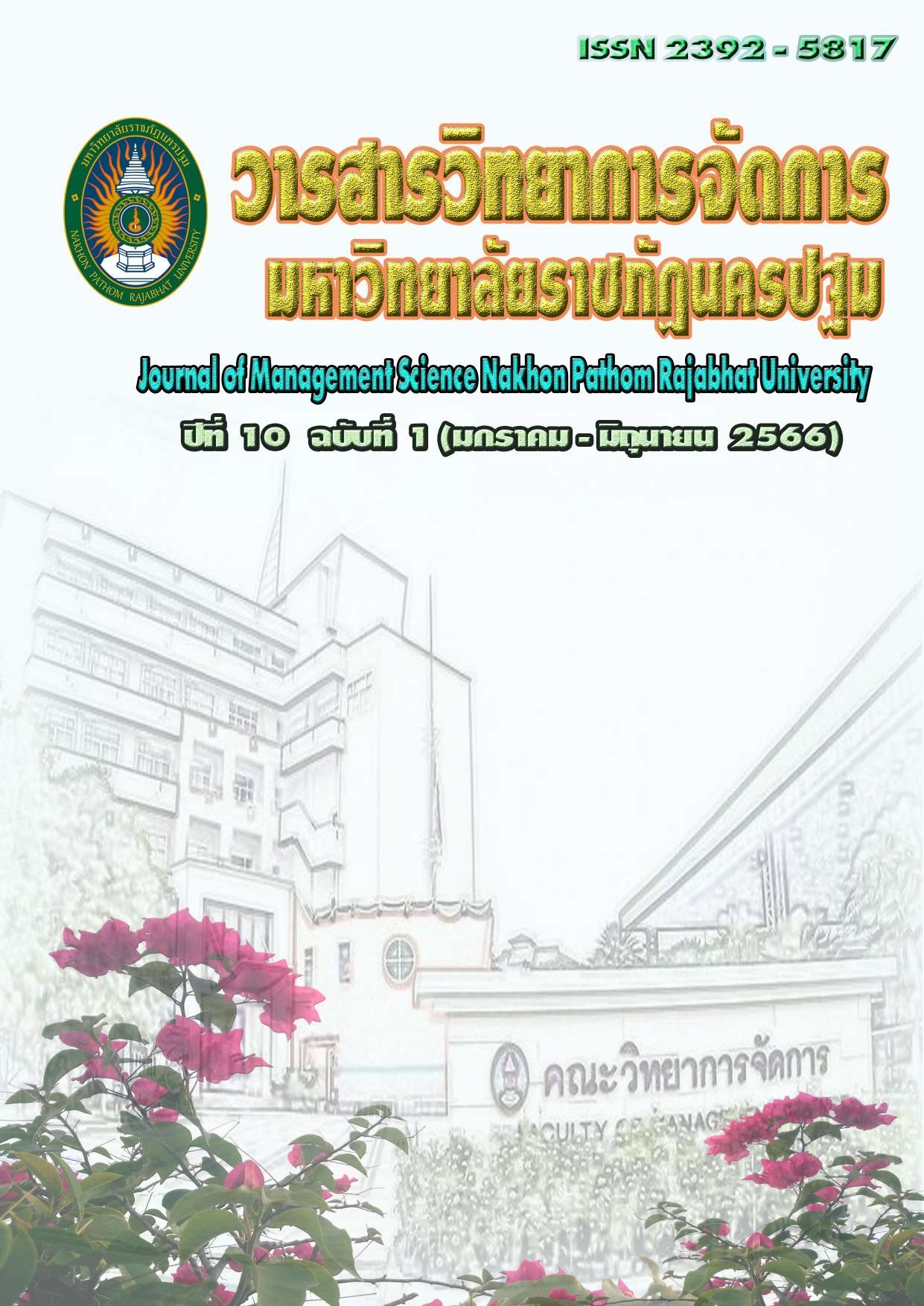การทำงานทางไกลในสถานการณ์ COVID – 19 ขององค์การภาครัฐไทย
Main Article Content
บทคัดย่อ
การวิจัยนี้มีวัตถุประสงค์เพื่อศึกษา ความพร้อมของการทำงานทางไกลในสถานการณ์วิกฤต COVID -19 ขององค์การภาครัฐไทย และผลของการทำงานทางไกลที่มีต่อผลิตภาพขององค์การและความพึงพอใจในงานของบุคลากรภาครัฐ ผู้วิจัยใช้เทคนิคการวิจัยเชิงคุณภาพแบบกรณีศึกษา โดยกำหนดให้สำนักงานปลัดกระทรวงเกษตรและสหกรณ์ และกรมชลประทาน สังกัดกระทรวงเกษตรและสหกรณ์ เป็นกรณีศึกษา ผู้วิจัยเก็บข้อมูลโดยการสัมภาษณ์เชิงลึกกับผู้ให้ข้อมูลสำคัญจากหน่วยงานทั้งสองรวมทั้งสิ้น 42 ตัวอย่าง นอกจากนี้ ยังมีการวิจัยเอกสาร การสังเกตแบบมีส่วนร่วมและไม่มีส่วนร่วมอีกด้วย ส่วนการวิเคราะห์ข้อมูลใช้วิธีการวิเคราะห์แบบอุปนัยและการสังเคราะห์ข้ามกรณีศึกษา ผลการศึกษาพบว่า
1) ความพร้อมของการทำงานทางไกลในสถานการณ์วิกฤต COVID-19 ขององค์การภาครัฐประกอบด้วย (1) ความพร้อมของผู้นำองค์การที่มีความกล้าในการตัดสินใจและมีคุณลักษณะภาวะผู้นำเชิงนวัตกรรม (2) ความพร้อมในการปรับเปลี่ยนองค์การ (3) ความพร้อมของบุคลากรในทักษะการทำงานทางไกล (4) ความพร้อมของอุปกรณ์เทคโนโลยีดิจิทัล โปรแกรมการสื่อสารและการเชื่อมต่อที่ปลอดภัย และ (5) ความพร้อมของสถานที่ทำงานทางไกล
2) ความพร้อมของการทำงานทางไกลส่งผลต่อความพึงพอใจในงานของบุคลากร โดยงานที่เหมาะสมที่จะทำงานทางไกลได้แก่ งานที่สามารถใช้ระบบเทคโนโลยีทดแทนหรือสนับสนุนการปฏิบัติงานได้ เช่น งานอนุมัติ อนุญาต งานให้คำปรึกษาแนะนำ งานให้บริการประชาชน งานบริหาร งานวางแผนและพัฒนานโยบาย งานวิชาการ วิเคราะห์ วิจัย ฯลฯ ในขณะที่บางลักษณะงานไม่สามารถทำงานทางไกลได้ เช่น งานด้านวิศกรรรม งานด้านอุทกวิทยา เป็นต้น ถึงแม้การทำงานทางไกลส่งผลให้ขาดการมีปฏิสัมพันธ์ระหว่างเพื่อนร่วมงานและผู้บังคับบัญชา แต่องค์การภาครัฐได้มีการกำกับติดตามการทำงานทางไกลและการดูแลในเรื่องของค่าจ้างและสวัสดิการที่เป็นธรรมตามกฎระเบียบของทางราชการ มีนโยบายการทำงานทางไกลที่ชัดเจน และมีการทบทวนนโยบายการทำงานอย่างสม่ำเสมอ ส่งผลให้บุคลากรมีความพึงพอใจในงาน และ
3) ความพร้อมของการทำงานทางไกลส่งผลต่อผลิตภาพขององค์การ โดยองค์การภาครัฐมีการนำเทคโนโลยีดิจิทัลมาปรับใช้เพื่อลดขั้นตอนและระยะเวลาในการให้บริการ จึงทำให้ผู้รับบริการเกิดความพึงพอใจ ส่งผลให้ประหยัดงบประมาณ และเกิดความคุ้มค่าในทุกภารกิจ ดังนั้น การทำงานทางไกลจึงส่งผลให้องค์การภาครัฐมีประสิทธิภาพและประสิทธิผล หรืออาจกล่าวได้ว่ามีผลดีต่อผลิตภาพขององค์การ
* นักศึกษาปริญญาเอก โครงการปรัชญาดุษฎีบัณฑิต สาขาวิชารัฐประศาสนศาสตร์ คณะรัฐศาสตร์ มหาวิทยาลัยรามคำแหง 10240
** รองศาสตราจารย์ คณะรัฐศาสตร์ มหาวิทยาลัยรามคำแหง 10240
Corresponding author: email Kanlayakan84@gmail.com
Article Details

อนุญาตภายใต้เงื่อนไข Creative Commons Attribution-NonCommercial-NoDerivatives 4.0 International License.
ทัศนะและข้อคิดเห็นของบทความที่ปรากฏในวารสารฉบับนี้เป็นของผู้เขียนแต่ละท่าน ไม่ถือว่าเป็นทัศนะและความรับผิดชอบของกองบรรณาธิการ
เอกสารอ้างอิง
กระทรวงวิทยาศาสตร์และเทคโนโลยี, สำนักงานนวัตกรรมแห่งชาติ. (2555). การจัดการนวัตกรรมสำหรับผู้บริหาร (Innovation management for executives--IMEs). (พิมพ์ครั้งที่ 3). กรุงเทพมหานคร: สำนักงานนวัตกรรมแห่งชาติ
วลัยพร รัตนเศรษฐ และ สมศักดิ์ วานิชยาภรณ์. (2564). บทบาทของภาครัฐในการบริหารจัดการกับการแพร่ระบาดของโควิด-19. กรุงเทพมหานคร: คณะรัฐประศาสนศาสตร์ มหาวิทยาลัยธุรกิจบัณฑิตย์.
Agdalen, L. and Lehtisalo, S. (2019). Telework and job satisfaction. Liv Agdalen, Sara Lehtisalo: Stockholm Business School.
Atzeni, P., Mecca, G., and Merialdo, P. (1998). Design and maintenance of data-intensive websites. Heidelberg, Germany: Springer-Verlag.
Boeri, T., Caiumi, A. and Paccagnalla, M. (2020). Mitigating the work-safety trade-off. Covid economics: Vetted and real-time papers, 1(2). 60–66.
Johnston, R. (2013). Service productivity: Towards understanding the relationship between operational and customer productivity. International Journal of Productivity and Performance Management. 53(3), 201-213.
Kaliski, B. S. (2007). Encyclopedia of business and finance. (2nd ed., Vols. 2). Detroit, MI.: Thompson Gale.
Lugtu Jr., R. (2021). Work-from-home - are workers truly productive? The Manila Times. Retrieved April 18, 2021 from https://www.manilatimes.net/2021/05/27/business/top-
business/work-from-home-are-workers-truly-productive/1800805
Nilles, J. M. (1998). Managing telework: Strategies for managing the virtual workforce. (Vol. 6). New York, NY.: Wiley.
OECD Policy Response to Coronavirus (COVID-19). (2020). Productivity gains from teleworking in the post COVID-19 era: How can public policies make it happen? Retrieved April 18, 2021 from https://www.oecd.org/coronavirus/policy-responses/productivity-gains-from-teleworking-in-the-post-covid-19-era-how-can-public-policies-make-it-happen-a5d52e99/
Scarpello, V., and Campbell, J. P. (1983). Job satisfaction: Are all the parts there? Personnel Psychology. 36(3), 577-600.
Turcotte, M. (2010). Working at home: an update. Canadian social trends. Retrieved January 15, 2021, from https://www150.statcan.gc.ca/n1/pub/11-008-x/2011001/article/11366-eng.htm
Yasenov, V. I. (2020). Who can work from home? Retrieved January 15, 2021, from https://www. healthaffairs. org/topics.
Yin, R. K. (2015). Qualitative research from start to finish. (2nd ed.). New York: Guilford Press.


